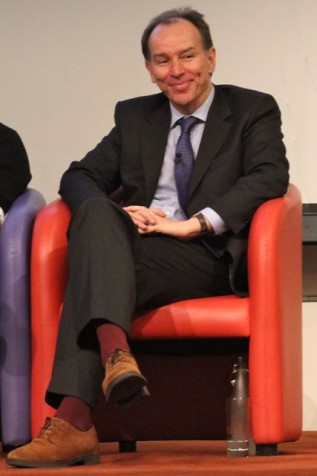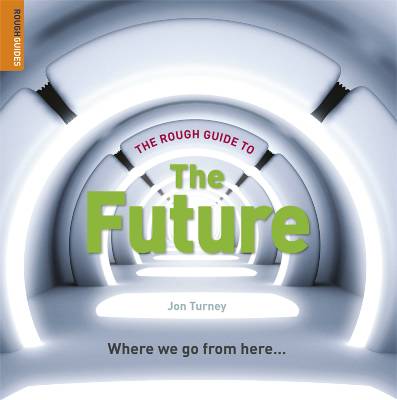- Paperback: 376 pages
- Publisher: Rough Guides (1 Nov 2010)
- Language English
- ISBN-10: 1858287812
- ISBN-13: 978-1858287812
On the technology website Ars Technica last week, Jonah Lehrer argued that taking a sneaky peep at the end of a novel to see how the plot works out needn’t necessarily spoil a good read.
For myself, I quite like surprises, in fiction at least, so for the foreseeable future I’ll be taking my revelations, denouements, and tricks-of-the-tale in the order the author intended.
Real life’s different though, and I do for the most part like to see what’s coming. And, for sure, there are any number of would-be oracles, specialists, think-tanks, and other miscellaneous pundits ready to enlighten me.
But therein lies a problem. When the brain gets too much information from too many sources it doesn’t cope so well. And given that this is all important stuff we need to have an opinion on: over-population, global warming, peak oil, mass epidemics, starvation, save the panda – asteroid strikes; what’s needed is someone to critically scan, boil down, and filter the myriad forecasts and predictions into a digestible round-up.
Enter Jon Turney’s latest book, The Rough Guide to The Future
(The Rough Guide to The Future (Rough Guide Reference))
‘Rough’ is a curious term to describe a guide that in style, by my reckoning, is both scholarly and popular; but, as Turney says, it’s really more of a recognition that no study about everything can ever be complete.
All the same, Rough Guide to the Future is as comprehensive an analysis of forecast data and topical opinion that you’re likely to find, and one I heartily recommend.
I should also say that I read the Guide, in a fitting juxtaposition of futurity with the primal, on my smartphone whilst halfway up a mountain in a tent. And while I’m sure there’s virtue in that, I’m missing the pencil scrawl and Post-its I’d ordinarily now be pawing over for a review. Kindle highlights and notes just don’t do it for me.
Here goes anyhow.

In terms of the certainty of its themes and predictions, the Guide follows a sort of three part soft-hard-soft progression. Kicking off with a more philosophical discussion around types of futurity and the methods of futurology, there follows a middle section on relatively near-reach developments on issues we really need to sort this century – so a focus on the 50-100 year time scale. With more speculative and far-reaching ideas boxed off in the later chapters, it’s an effective mix that majors on practical concerns but with plenty of material to keep budding futurists, sci-fi enthusiasts, and philosophy types on board.
Chapters combine quotations, literature survey, case studies, a Prediction File, and a Further Exploration section (references to futurist texts, various government, NGO and think-tank reports, plus a good dose of science fiction). The Guide is packed with helpful hyperlinks.
The Predictions Files capture the diverse views of fifty invited commentators asked for their highest hope, greatest fear, and best bet for the future. Turney’s own replies give something of the flavour:
Highest Hope: “We navigate through the eye of the needle of the middle decades of the century well enough to allow the bottom billion a real chance of a humane life.”
Worst Fear: “The environmental calamity so many informed scientists predict gathers pace faster than our efforts to forestall it.”
Best Bet: “Crises, muddling through and continuing vast inequalities are the order of the day. In spite of that, it remains, technologically and culturally, the most fascinating of times to be alive.”
Scanning the whole set is a roller-coaster ride between optimism and pessimism. From Anne Skare Nielsen’s High Hope along the lines of the world being what we make it:
“That the majority of the world’s inhabitants will come to the sensible conclusion that if we keep on asking others to change, nothing grand will ever happen. That we – as Buddhists say – have to be the change we want to see in other people. We should stop instructing and start constructing. I hope that we can let go of our need to control, learn to “listen louder” and co-create better solutions that will bring out the best in people”
to the sombre hopelessness of Sohail Inayatullah’s Greatest Fear:
“Endless fear, endless poverty, endless loss of spirit, continued nationalism, crisis after crisis with the inability to see the links, deeper causes, or pattern of crises.”
I touched on ideas from the first part of the book, related to time perception and the nature of past and future in my last blog post, so won’t expand further here.
The ‘hard’ ground at the core of the Guide comprises discrete chapters on what Turney calls Global Basics: energy, climate, water, food, health, biodiversity, war, and disasters. These are preceded and supported by generic discussions on science futures and population, and followed by material covering softer issues (but not as speculative as those in later chapters) around life, societal values, economic models and sustainability, and global cooperation – the logic being these topics overlay or integrate with the Global Basics. In the chapter Life, Society and Values, I particularly liked the description of Futurelabs’ 3-Worlds exercise, that considers how the world might look were we to adopt or migrate to different sets of dominant social values.
I’m not about to trot through each and every Global Basic here, but it’s impossible to write, or write-up, a guide to the future without mentioning energy and climate change.
Unfortunately, the problems associated with climate change come in two flavours neither of which, as a species, we’ve met before on any scale or have a record of resolving: (a) their impact is global and therefore shared, and (b) they operate over multi-generational timescales. The challenge is well summed up in former Shell chairman Ron Oxburgh’s Worst Fear:
“That each country acts in its own perceived short term interests in the belief that this will maintain or raise its economic competitiveness; that emissions will continue to rise, and wealthy nations will use their wealth and technology to achieve a degree of short-term adaptation to a rapidly deteriorating climate, allowing the developing world to take its chances.”
If there’s one common message from the whole guide, but particularly the Global Basics discussion, for me it’s the need not to see our scientific, technical, societal, and political futures in isolation. It’s easy to retreat to a technical focus, but some thought leaders are striving for the bigger picture – as challenging a task as that might be. This quote from Tim Jackson of the UK’s Sustainable Development Commission stuck with me:
“the reason why nobody asks the difficult questions that we are asking here is because nobody really has any answers to them”
A somewhat depressing prospect given that the difficult questions are also the important ones. For me, the apparent absence of any roadmap to transition from what we appear to be in – a treadmill of unsustainable, consumer-driven growth, is deeply worrying. Few believe this is the century mankind will ramp up to some Utopian ideal, but it will be a poor show if we can’t make substantive corrections to the inequalities in health, wealth and opportunity that characterise today’s (in)humanity.
Incidentally, another message I gleaned from the Guide is that forecasts are, or should be, constantly revised – and some, like the impact of birth rate on future population, are sensitive to small changes. Likewise the need to question received truths and revisit sources.
Moving to more speculative territory in the last third of the Guide, I should mention how through his many references Turney pays tribute to science fiction. Since the 19th century, science fiction writers have painted imaginative alternative futures built around surreal technologies, alien life, and revolutionary social orders; and the fiction of the past has often become the fact of the future.
I’ve never been a science fiction nut, but remember as a teenager lapping up futurist works like Arthur C Clarke’s Profiles of the Future and Report on Planet 3, then in the 90’s Francis Kinsman’s Millenium 2000, and most recently Damien Broderick’s Year Million collection. Now, thanks to the Guide, I’ve rediscovered the works of H.G.Wells and W.Olaf Stapledon – who both convince me how few ideas are truly new.
There’s discussion around life extension, cryogenic preservation, and transhumanism – including the increasingly ubiquitous concept of The Singularity, a condition some think will arise, even within the next 50 years, whereby technology and artificial intelligence will run exponentially away from us, designing and building ever superior versions of itself – even attaining its own form of consciousness. My take from the Guide on this? The jury is still well and truly out.
The good news is that through improved nutrition and medicine many more people will be living very much longer (but not necessarily at their leisure). And through genetic upgrades, we’ll be enhancing our physical performance, visual range, and cognitive abilities. A brave new world made real.
Then there’s the prospect for life on other worlds, the concept of deep time, and the ultimate fate of life, the universe, and everything; which, cheerfully, boils down to the heat death of the universe in some tens of trillions of years: a concept clarified not as some giant toasting (although the Earth does get one of those along the way), but the end of heat, energy, and everything from the potato chip to the proton.
So sitting in my tent having completed the Guide, from the seemingly overwhelming challenges of Global Basics to the end of the universe, I ask myself the obvious question: “Does it really, cosmically speaking, matter if I don’t get up and go to work?….”.
At which point I remind myself I’ve two more weeks of holiday to go, and keep on smiling.
After all, there’s still time to put things right. And the end of the future is a long way off.
Other Information
Jon Turney’s blog at Unreliable Futures
Other reviews of Rough Guide to the Future
James Kingsland, Guardian 11/11/2011 The Rough Guide to the Future – Review

